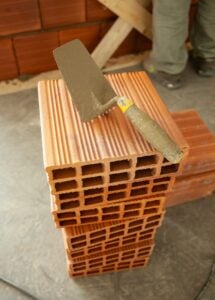Table of Contents
ToggleExplore unique brick patterns with expert tuckpointing techniques
If you’re a fan of vintage architecture, you’re likely acquainted with the charisma and enchantment of brick buildings. Yet, age and weathering may wreak havoc on even the best-built brickwork. That’s where tuckpointing comes in.
The tuckpointing technique gives brickwork new vitality by removing the old, deteriorated mortar from the joints between the bricks and putting in new, fresh mortar. But did you know that various brick designs call for distinct tuckpointing methods?
In this article, we’ll explore five brick wall tuckpointing methods tailored to various brick patterns so you can maintain the pristine appearance of your brickwork.
5 Brick Patterns and Their Tuckpointing Techniques
Running Bond Pattern
- If you’ve ever lauded a brick wall and questioned how it was constructed, odds are, it was finished in the running bond pattern. Bricks are laid in this common pattern in a staggered arrangement to produce a classic, ageless appearance.
Tuckpointing is necessary if you want to give your running bond brickwork a brand-new appearance. First, remove the old mortar from the vertical joints and add fresh mortar to the horizontal joints.
- Cut a groove through the middle, leaving a narrow strip on either side, using a tuckpointing tool. In order to give the new mortar a smooth finish, shape it lastly using a pointed tool.
Flemish Bond Pattern
The Flemish bond pattern is an excellent choice for a decorative brick design that emanates elegance. In order to create a distinctive, striking design, it alternates among a sequence of stretchers and headers.
- If you’re tuckpointing this particular pattern, the first step is to extract any deteriorated mortar from the vertical joints. Then, proceed to fill the horizontal joints with fresh mortar, making sure to fill them completely.
After that, use a tuckpointing tool to carve a groove into the center of the new mortar, being careful to leave a thin strip of mortar on both sides of the groove. Finally, precisely duplicate the original junction in the new mortar by forming a concave shape using a jointing tool.
Herringbone Pattern
- Herringbone is one of the most visually striking brick patterns, elevating any structure’s aesthetic appeal. An alluring zigzag pattern is created by placing bricks at a 45-degree angle.
Tuckpointing is a crucial process that needs a steady hand and close attention to detail when it comes to fixing a herringbone pattern brickwork. Although the initial steps of tuckpointing the herringbone pattern may resemble those of other brick patterns, it’s the last step that sets it apart.
- To begin, gently remove any old and worn-out mortar from the vertical joints to create a clean slate for the new mortar. Then, carefully apply fresh mortar to the horizontal joints, ensuring they are adequately filled.
With a tuckpointing tool, create a precise groove in the center of the new mortar, leaving just the right amount of space on either side. Finally, to acquire a new look, use a trowel to level the new mortar, aligning it with the angle of the adjoining bricks in the herringbone pattern.
- The final result will be a brilliantly restored herringbone pattern brickwork guaranteed to impress, but the technique calls for patience and accuracy.
Basket Weave Pattern
The basket weave pattern is an intricate design that interlaces pairs of bricks perpendicular to each other, creating a visually captivating woven effect. To tuckpoint this type of brickwork – yes, you guessed it right – start by removing deteriorated mortar from vertical joints!
- Next, use the new mortar to fill the horizontal joints completely. Using a tuckpointing tool, carefully cut a groove down the center of the new mortar, leaving a delicate strip on either side.
But the magic of tuckpointing a basket weave lies in the final step, where you use a jointing tool to create a concave shape in the new mortar. This creates a perfect replica of the original joint and revitalizes your basket weave brickwork, restoring it to its former glory.
The Stacked Bone Pattern
 Less can sometimes be more. The stacked bond pattern is a basic yet practical brick pattern that stacks bricks in a straight, vertical line.
Less can sometimes be more. The stacked bond pattern is a basic yet practical brick pattern that stacks bricks in a straight, vertical line.
Well, we have decided not to bore you with the repetitive tuckpointing steps for the final brick pattern and will take you directly to the final step! The last step entails making a flat surface that resembles the surface of the nearby bricks using a pointing instrument.
- This method gives you a neat, modern appearance that goes well with the stacked bond pattern’s simplicity.
In conclusion, tuckpointing is an essential procedure for maintaining the aesthetic appeal and structural soundness of your brickwork, and each brick pattern necessitates a different method.
The tuckpointing professionals at Dupont Tuckpointing have the knowledge and experience necessary to restore your brickwork to its former glory, regardless of whether it has a Flemish bond, herringbone, stacked bond, or basket weave pattern.
Don’t let the elements, passing time, or ignorance diminish the beauty of your brickwork. Please set up a meeting with Dupont Tuckpointing right now to find out how we can help give your brickwork a new lease on life.




